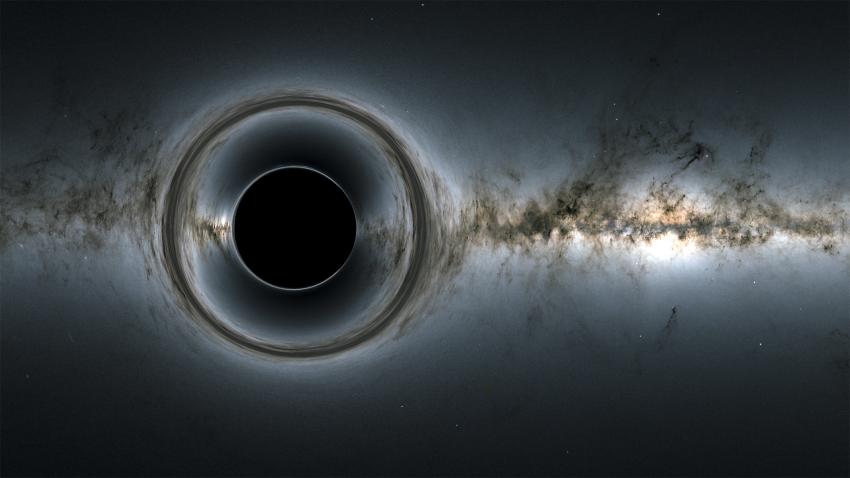A research team from the Open University and the University of Southampton is asking for the public’s help to find some of the most mysterious, elusive objects in the Universe – black holes. By examining data from the SuperWASP survey, the UK's leading extra-solar planet detection programme, the team hope to detect changes in starlight that may provide evidence for the existence of these black holes.
The most massive stars explode when they get old, and what is left of the star after the explosion gets condensed into an extremely small area - a black hole. Containing roughly the same amount of mass as our Sun, and compressed into a space that’s only a few miles across, black holes have a very strong gravitational field that nothing – not even light – can escape. Because of this, black holes can be difficult to detect, but they can often be found when material is falling into them – a process known as feeding. Because of their strong gravitational pull, matter falls in so rapidly that it heats up and emits strong X-rays, allowing feeding black holes to be found.
But not all black holes are feeding. The black holes that the team are trying to detect are hidden because nothing is falling in, so there are no tell-tale x-rays to give them away. Luckily, their gravity can still hint at where they might be. The gravity of a black hole is strong enough that it can bend light from stars, acting like a magnifying glass that makes the star’s light appear brighter for a short period of time.
The team is looking in an archive of over 10 years’ worth of measurements from the SuperWASP survey, trying to find any stars that have been magnified by black holes. But there are a lot of stars to look at, and this isn’t a job that computers can do.
Members of the public can join the search by visiting the Black Hole Hunters project site. All you need to do is look at a few simple graphs of how the brightness of stars changed and let the team know if any look like the types of changes they’re looking for.
Adam McMaster, one of the co-leads of the project, says “I can’t wait to see what we find with the Black Hole Hunters project. The black holes we’re looking for should definitely exist, but none have been found yet. Our search should give us the first hints about how many black holes are quietly orbiting stars, eventually helping us to understand the way such systems form.” He adds, “Finding them is a huge task and it’s not something we could do alone, so it’s great that anyone with access to the Internet will be able to get involved no matter how much they know about astronomy.”
Media contacts
Dr Robert Massey
Royal Astronomical Society
Tel: +44 (0)20 7292 3979
Mob: +44 (0)7802 877 699
nam-press@ras.ac.uk
Ms Gurjeet Kahlon
Royal Astronomical Society
Mob: +44 (0)7802 877700
nam-press@ras.ac.uk
Ms Cait Cullen
Royal Astronomical Society
nam-press@ras.ac.uk
Science contacts
Adam McMaster
The Open University
adam.mcmaster@open.ac.uk
Dr Hugh Dickinson
The Open University
hugh.dickinson@open.ac.uk
Dr Matthew Middleton
University of Southampton
m.j.Middleton@soton.ac.uk
Further information
Image: https://nam2022.org/images/simulated_bh.jpg
Caption:This simulation of a supermassive black hole shows how it distorts the starry background and captures light, producing a black hole silhouettes. Credit: NASA’s Goddard Space Flight Center; background, ESA/Gaia/DPAC
Notes for editors
About NAM 2022
The NAM 2022 conference is principally sponsored by the Royal Astronomical Society (RAS), the Science and Technology Facilities Council (STFC) and the University of Warwick. Keep up with the latest conference news on Twitter.
About the Royal Astronomical Society
The Royal Astronomical Society (RAS), founded in 1820, encourages and promotes the study of astronomy, solar-system science, geophysics and closely related branches of science. The RAS organises scientific meetings, publishes international research and review journals, recognises outstanding achievements by the award of medals and prizes, maintains an extensive library, supports education through grants and outreach activities and represents UK astronomy nationally and internationally. Its more than 4,000 members (Fellows), a third based overseas, include scientific researchers in universities, observatories and laboratories as well as historians of astronomy and others.
Follow the RAS on Twitter, Facebook, Instagram and YouTube. Listen and subscribe to the Supermassive Podcast here.
About the Science and Technology Facilities Council
The Science and Technology Facilities Council (STFC) is part of UK Research and Innovation – the UK body which works in partnership with universities, research organisations, businesses, charities, and government to create the best possible environment for research and innovation to flourish. STFC funds and supports research in particle and nuclear physics, astronomy, gravitational research and astrophysics, and space science and also operates a network of five national laboratories, including the Rutherford Appleton Laboratory and the Daresbury Laboratory, as well as supporting UK research at a number of international research facilities including CERN, FERMILAB, the ESO telescopes in Chile and many more.
STFC's Astronomy and Space Science programme provides support for a wide range of facilities, research groups and individuals in order to investigate some of the highest priority questions in astrophysics, cosmology and solar system science. STFC's astronomy and space science programme is delivered through grant funding for research activities, and also through support of technical activities at STFC's UK Astronomy Technology Centre and RAL Space at the Rutherford Appleton Laboratory. STFC also supports UK astronomy through the international European Southern Observatory and the Square Kilometre Array Organisation.
Follow STFC on Twitter.
About the University of Warwick
The University of Warwick is one of the world’s leading research institutions, ranked in the UK’s top 10 and world top 80 universities. Since its foundation in 1965 Warwick has established a reputation of scientific excellence, through the Faculty of Science, Engineering and Medicine (which includes WMG and the Warwick Medical School).


